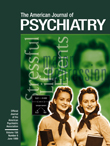Psychotherapy With a Borderline Patient
To the Editor: I read with great interest the recent Clinical Case Conference by Joan Wheelis, M.D., about her psychotherapy with a borderline patient and the subsequent discussion by John G. Gunderson, M.D. (1). However, after nine pages of detailed text, I was struck by the one-paragraph dismissal of Ms. A’s decision to terminate treatment when her mother became ill with leukemia. This sudden and seemingly premature termination of the discussion seemed to mirror an abrupt termination of therapy. The impending mortality of the mother and Ms. A’s termination of her relationship with her therapist seem to annihilate this fragile patient’s only support system. In a teaching article like this, I believe such circumstances warrant a detailed discussion of how a therapist should handle a patient’s impending loss, a patient’s desire to terminate therapy prematurely, and most important, an assessment and treatment of dangerousness in such circumstances with a borderline patient.
In reviewing her history, Ms. A presented with suicidality and substance abuse following the loss of an 8-year boyfriend and the recent termination with her 10-year therapist due to the therapist’s geographical relocation. Her earliest memory described a destructive reaction at age 3 following the loss of exclusive parental attention when her sister was born, and her first wrist slashing was at age 16 after the breakup of an intense 4-year friendship, which led Ms. A to deteriorate drastically in her school performance. Then, just when Ms. A was beginning to explore her feelings about her mother in therapy and “important changes were occurring in that relationship,” her mother acquired an apparently fatal illness.
Given such a history of dramatic, self-destructive acting out after perceived losses, a therapist should be very concerned about Ms. A’s ability to tolerate the loss of her mother, especially when she was beginning to deal with this relationship in therapy. The article merely states that Ms. A “experienced this possible loss as in direct conflict with her therapeutic task of exploring and tolerating her disappointments with her mother.” It seems that the larger therapeutic task was for Ms. A to explore and tolerate her disappointments and losses in life and that the impending death of her mother provided the therapist with exactly such a situation in which to assist Ms. A in working through.
Dr. Wheelis was extremely honest in her countertransference commentary, and she appeared genuinely invested in the therapeutic relationship. I would welcome her thoughts and discussions with Ms. A when she wanted to terminate treatment because her mother was dying. Dr. Gunderson’s expert advice concerning these circumstances would also be most helpful to the average therapist, who is only too often faced with a potentially lethal borderline patient who rejects the therapist at a time of increased vulnerability.
1. Wheelis J, Gunderson JG: A little cream and sugar: psychotherapy with a borderline patient. Am J Psychiatry 1998: 155:114–122Google Scholar



